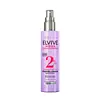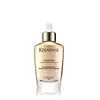What's inside
What's inside
 Key Ingredients
Key Ingredients

 Benefits
Benefits

 Concerns
Concerns

 Ingredients Side-by-side
Ingredients Side-by-side

Water
Skin ConditioningPolyquaternium-37
Parfum
MaskingPropylene Glycol Dicaprylate/Dicaprate
EmollientPolysorbate 20
EmulsifyingQuaternium-87
CleansingStearyl Alcohol
EmollientGlycine Soja Oil
EmollientSodium Benzoate
MaskingCaprylyl Glycol
EmollientBehentrimonium Chloride
PreservativePPG-1 Trideceth-6
Skin ConditioningCocos Nucifera Oil
MaskingCandelilla Cera
EmollientPropylene Glycol
HumectantCitric Acid
BufferingIsopropyl Alcohol
SolventSorbitan Oleate
EmulsifyingPentaerythrityl Tetra-Di-T-Butyl Hydroxyhydrocinnamate
AntioxidantPolyquaternium-11
Sodium Hyaluronate
HumectantLimonene
PerfumingCoumarin
PerfumingWater, Polyquaternium-37, Parfum, Propylene Glycol Dicaprylate/Dicaprate, Polysorbate 20, Quaternium-87, Stearyl Alcohol, Glycine Soja Oil, Sodium Benzoate, Caprylyl Glycol, Behentrimonium Chloride, PPG-1 Trideceth-6, Cocos Nucifera Oil, Candelilla Cera, Propylene Glycol, Citric Acid, Isopropyl Alcohol, Sorbitan Oleate, Pentaerythrityl Tetra-Di-T-Butyl Hydroxyhydrocinnamate, Polyquaternium-11, Sodium Hyaluronate, Limonene, Coumarin
Water
Skin ConditioningPolyquaternium-37
Paraffinum Liquidum
EmollientAmodimethicone
Polysorbate 20
EmulsifyingQuaternium-87
CleansingStearyl Alcohol
EmollientMenthoxypropanediol
MaskingBehentrimonium Chloride
PreservativeSafflower Glucoside
Candelilla Cera
EmollientPPG-1 Trideceth-6
Skin ConditioningChlorhexidine Digluconate
AntimicrobialTrideceth-6
EmulsifyingMalus Domestica Fruit Cell Culture Extract
Skin ConditioningPolyquaternium-11
2-Oleamido-1,3-Octadecanediol
Skin ConditioningCetrimonium Chloride
AntimicrobialCamellia Sinensis Leaf Extract
AntimicrobialParfum
MaskingWater, Polyquaternium-37, Paraffinum Liquidum, Amodimethicone, Polysorbate 20, Quaternium-87, Stearyl Alcohol, Menthoxypropanediol, Behentrimonium Chloride, Safflower Glucoside, Candelilla Cera, PPG-1 Trideceth-6, Chlorhexidine Digluconate, Trideceth-6, Malus Domestica Fruit Cell Culture Extract, Polyquaternium-11, 2-Oleamido-1,3-Octadecanediol, Cetrimonium Chloride, Camellia Sinensis Leaf Extract, Parfum
 Reviews
Reviews

Ingredients Explained
These ingredients are found in both products.
Ingredients higher up in an ingredient list are typically present in a larger amount.
This ingredient is a preservative and often used for it's anti-static properties. You'll most likely see this ingredient in hair conditioners.
It does not cause irritation or sensitization in leave-on products at 1-5%.
Candelilla Cera isn't fungal acne safe.
Parfum is a catch-all term for an ingredient or more that is used to give a scent to products.
Also called "fragrance", this ingredient can be a blend of hundreds of chemicals or plant oils. This means every product with "fragrance" or "parfum" in the ingredients list is a different mixture.
For instance, Habanolide is a proprietary trade name for a specific aroma chemical. When used as a fragrance ingredient in cosmetics, most aroma chemicals fall under the broad labeling category of “FRAGRANCE” or “PARFUM” according to EU and US regulations.
The term 'parfum' or 'fragrance' is not regulated in many countries. In many cases, it is up to the brand to define this term.
For instance, many brands choose to label themselves as "fragrance-free" because they are not using synthetic fragrances. However, their products may still contain ingredients such as essential oils that are considered a fragrance by INCI standards.
One example is Calendula flower extract. Calendula is an essential oil that still imparts a scent or 'fragrance'.
Depending on the blend, the ingredients in the mixture can cause allergies and sensitivities on the skin. Some ingredients that are known EU allergens include linalool and citronellol.
Parfum can also be used to mask or cover an unpleasant scent.
The bottom line is: not all fragrances/parfum/ingredients are created equally. If you are worried about fragrances, we recommend taking a closer look at an ingredient. And of course, we always recommend speaking with a professional.
Learn more about ParfumWe don't have a description for Polyquaternium-11 yet.
We don't have a description for Polyquaternium-37 yet.
Polysorbate 20 is made by combining ethoxylation of sorbitan, ethylene oxide, and lauric acid. It is a mild cleansing agent, surfactant, and emulsifier.
As a surfactant, it helps collect dirt and oils for washing. Emulsifiers prevent oils and water from separating.
Polysorbate 20 also adds scent to a product. Since it is made using sorbitol, it has a sweet scent. Sorbitol can also be found in fruits such as apples and peaches.
The lauric acid used to create Polysorbate 20 is often derived from coconuts.
Polysorbate 20 may not be fungal acne safe.
Learn more about Polysorbate 20We don't have a description for PPG-1 Trideceth-6 yet.
We don't have a description for Quaternium-87 yet.
Stearyl Alcohol is a type of fatty alcohol from stearic acid. It is a white, waxy compound used to emulsify ingredients.
Fatty Alcohols are most often used as an emollient or to thicken a product. Emollients help soothe and hydrate the skin by trapping moisture.
They are usually derived from natural fats and oils and therefore do not have the same drying or irritating effect as solvent alcohols. FDA allows products labeled "alcohol-free" to have fatty alcohols.
Learn more about Stearyl AlcoholWater. It's the most common cosmetic ingredient of all. You'll usually see it at the top of ingredient lists, meaning that it makes up the largest part of the product.
So why is it so popular? Water most often acts as a solvent - this means that it helps dissolve other ingredients into the formulation.
You'll also recognize water as that liquid we all need to stay alive. If you see this, drink a glass of water. Stay hydrated!
Learn more about Water